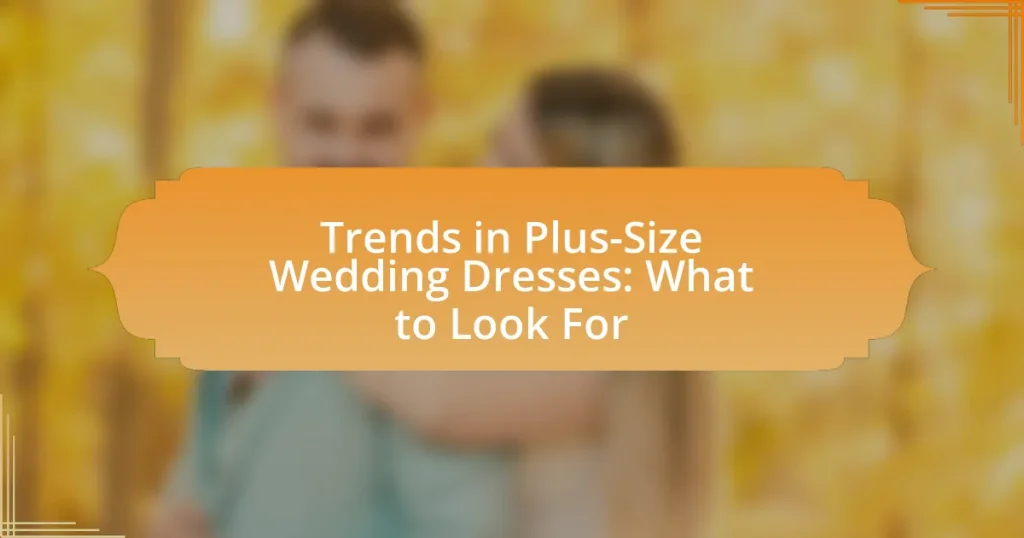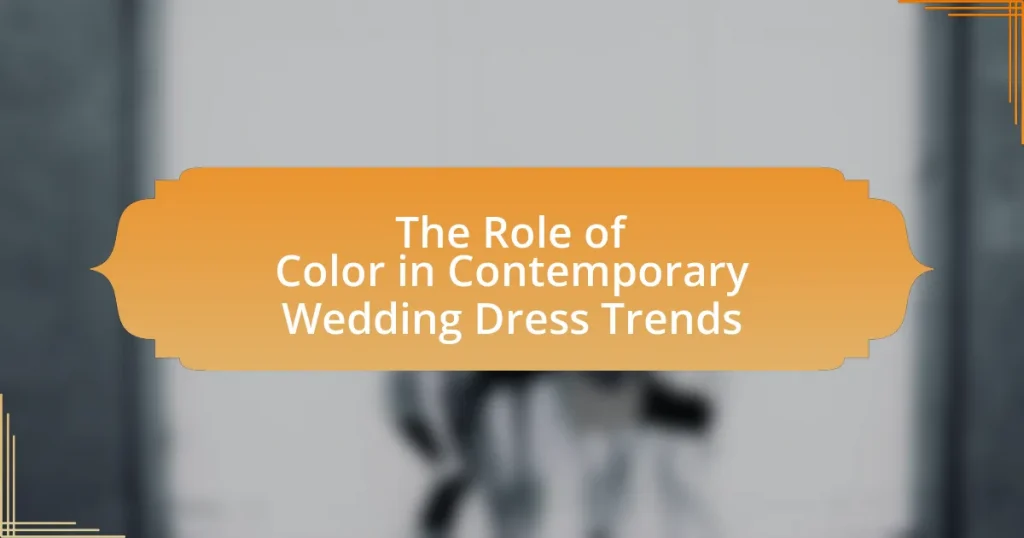Bridal styles for second weddings prioritize elegance and personal expression, moving away from traditional white gowns. Popular choices include sophisticated cocktail dresses, tailored suits, and tea-length gowns in softer or bolder colors that reflect the bride’s personality. The article explores how second wedding attire differs from first weddings, influenced by cultural factors and personal experiences, emphasizing simplicity and individuality. It also discusses the importance of selecting appropriate styles based on formality, venue, and personal comfort, while highlighting common mistakes to avoid and practical tips for choosing the perfect attire.
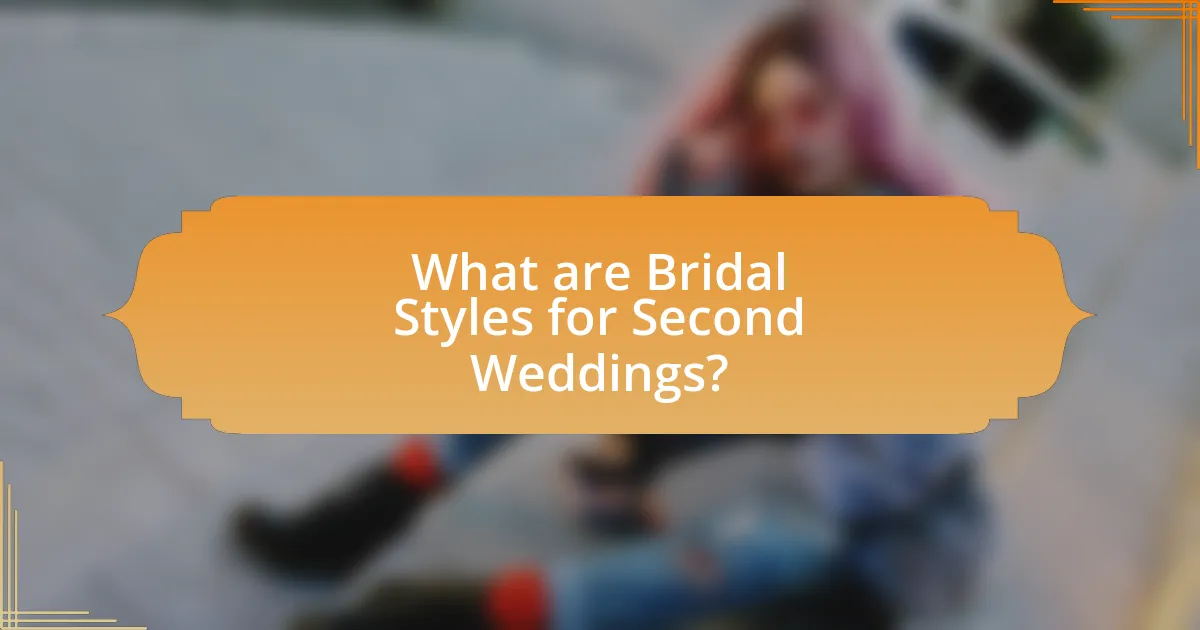
What are Bridal Styles for Second Weddings?
Bridal styles for second weddings typically emphasize elegance and personal expression while avoiding traditional white gowns. Popular options include sophisticated cocktail dresses, tailored suits, and elegant tea-length gowns, which provide a modern twist on bridal attire. Many brides opt for softer colors like champagne, blush, or even bold hues that reflect their personality, moving away from the conventional bridal palette. Additionally, brides may choose to incorporate unique accessories, such as statement jewelry or non-traditional veils, to enhance their individual style. This approach aligns with the growing trend of personalized weddings, where the focus is on the couple’s unique story rather than adhering strictly to traditional norms.
How do second wedding bridal styles differ from first wedding styles?
Second wedding bridal styles typically differ from first wedding styles by emphasizing simplicity, elegance, and personal expression over traditional expectations. Brides often choose less formal attire, such as cocktail dresses or tailored suits, reflecting a more relaxed approach to the ceremony. Additionally, second wedding dresses may feature unique designs, colors, or fabrics that align with the bride’s personal style rather than adhering to conventional bridal norms. This shift is supported by trends indicating that many brides prioritize comfort and individuality in their second weddings, moving away from the elaborate gowns often associated with first weddings.
What cultural factors influence bridal styles for second weddings?
Cultural factors influencing bridal styles for second weddings include societal norms, personal beliefs, and family traditions. In many cultures, second weddings may emphasize a more understated elegance compared to first weddings, reflecting a shift in priorities and experiences. For instance, in Western cultures, brides often opt for simpler dresses or non-traditional colors, symbolizing a more mature approach to marriage. Additionally, some cultures may incorporate specific rituals or attire that honor previous unions while celebrating new beginnings, such as wearing heirloom pieces or incorporating elements from the first wedding. These choices are often guided by the desire to balance respect for past relationships with the excitement of a new chapter.
How do personal experiences shape choices in second wedding attire?
Personal experiences significantly influence choices in second wedding attire by reflecting individual journeys and emotional growth. For instance, individuals may opt for simpler, more understated designs to symbolize a mature understanding of love, contrasting with the elaborate styles often chosen for first weddings. Additionally, past experiences, such as previous relationship dynamics or personal transformations, can lead to preferences for specific colors or styles that resonate with their current identity. Research indicates that emotional connections to attire can enhance the overall wedding experience, making choices more meaningful and personalized.
Why is it important to choose an appropriate style for a second wedding?
Choosing an appropriate style for a second wedding is important because it reflects the unique circumstances and emotional significance of the event. A second wedding often involves blending families and acknowledging past experiences, so selecting a style that resonates with these factors can foster a sense of respect and celebration. For instance, a more understated or personalized approach may be suitable, as it can convey maturity and a deeper understanding of commitment. Research indicates that couples who thoughtfully consider their wedding style report higher satisfaction levels, as it aligns with their values and the new chapter they are embarking on together.
What considerations should be made regarding formality and venue?
When planning a second wedding, considerations regarding formality and venue are crucial to ensure the event aligns with the couple’s preferences and the occasion’s significance. The formality of the wedding should reflect the couple’s relationship history and the tone they wish to set; for instance, a more casual setting may be appropriate for a second wedding, while a formal ceremony could honor the couple’s commitment.
The venue selection should also consider the couple’s personalities and the number of guests, as intimate gatherings may suit smaller, less formal venues, while larger celebrations might require more traditional spaces. Additionally, the venue’s ambiance should complement the chosen formality; for example, a beach or garden setting may lend itself to a relaxed atmosphere, whereas a banquet hall may suggest a more formal event.
Ultimately, aligning the formality and venue with the couple’s vision and the nature of their relationship will create a meaningful and memorable experience.
How can a bride reflect her personality through her second wedding style?
A bride can reflect her personality through her second wedding style by choosing attire, themes, and details that resonate with her individual tastes and experiences. For instance, a bride who values simplicity may opt for a minimalist gown, while one who enjoys vibrant colors might select a bold dress or unique accessories. Additionally, incorporating personal elements such as favorite flowers, meaningful music, or a specific venue that holds significance can further showcase her personality. This approach aligns with the trend of personalized weddings, where 70% of couples now prioritize unique elements that reflect their identities, as noted in wedding industry reports.
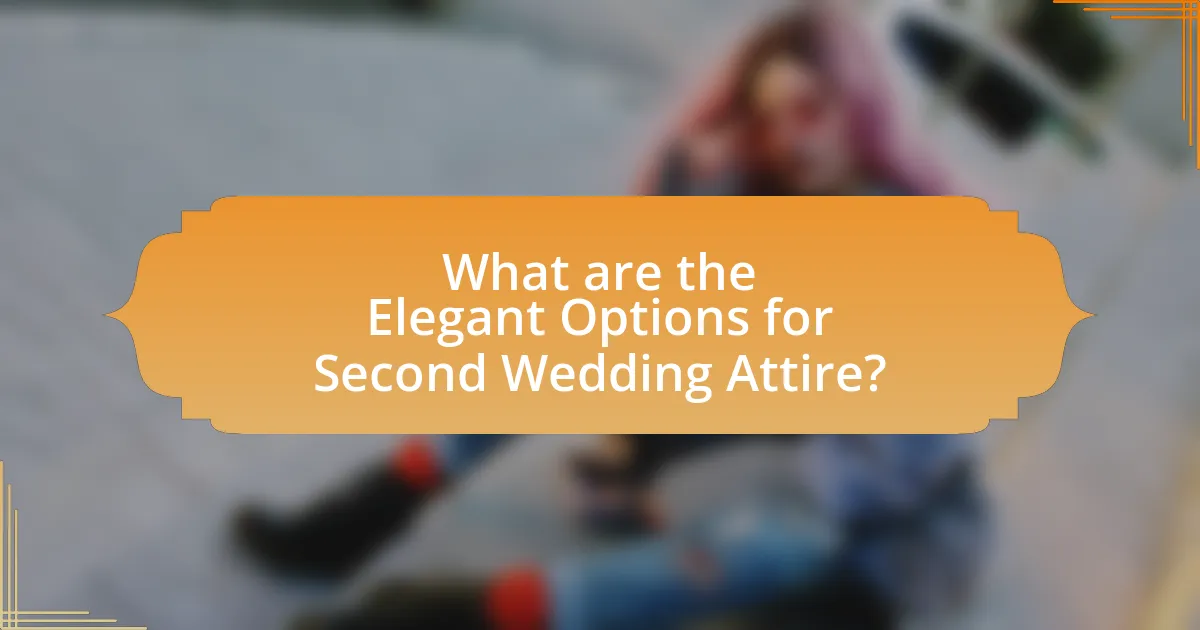
What are the Elegant Options for Second Wedding Attire?
Elegant options for second wedding attire include tailored suits, sophisticated cocktail dresses, and chic jumpsuits. Tailored suits offer a modern and polished look, often in luxurious fabrics like silk or satin, which can be complemented with elegant accessories. Sophisticated cocktail dresses, typically knee-length or midi, provide a feminine touch while maintaining a level of formality suitable for a wedding. Chic jumpsuits, designed with elegant cuts and embellishments, present a contemporary alternative that combines comfort with style. These options reflect a balance of elegance and appropriateness, catering to the unique nature of second weddings.
What types of dresses are popular for second weddings?
Popular dress types for second weddings include cocktail dresses, tea-length gowns, and elegant jumpsuits. These styles are favored for their sophistication and versatility, allowing brides to express their personal style while maintaining a sense of appropriateness for a second ceremony. Cocktail dresses offer a chic and modern look, while tea-length gowns provide a classic yet playful option. Jumpsuits have gained popularity for their contemporary appeal and comfort, making them a stylish alternative to traditional wedding dresses.
How do tea-length and knee-length dresses fit into second wedding styles?
Tea-length and knee-length dresses are increasingly popular choices for second weddings due to their blend of elegance and practicality. These dress lengths offer a sophisticated yet relaxed aesthetic, making them suitable for various wedding settings, from intimate ceremonies to casual receptions. The versatility of tea-length and knee-length dresses allows brides to express their personal style while adhering to the less formal nature often associated with second weddings. Additionally, these styles can be easily accessorized, enhancing their appeal for brides seeking a unique yet appropriate look for their special day.
What role do colors play in selecting a second wedding dress?
Colors play a significant role in selecting a second wedding dress as they can convey personal style, signify new beginnings, and reflect the couple’s unique story. For instance, many brides opt for non-traditional colors like blush, champagne, or even bold hues to symbolize a fresh start and individuality, moving away from the conventional white associated with first weddings. Additionally, color choices can align with the wedding theme or season, enhancing the overall aesthetic. Research indicates that color psychology influences emotions and perceptions; for example, red can evoke passion, while blue may symbolize tranquility, allowing brides to express their feelings through their dress choice.
What accessories complement second wedding bridal styles?
Accessories that complement second wedding bridal styles include understated jewelry, elegant shawls or wraps, and sophisticated veils or headpieces. Understated jewelry, such as simple pearl earrings or delicate bracelets, enhances the overall look without overwhelming it, aligning with the more refined aesthetic often preferred for second weddings. Elegant shawls or wraps provide warmth and style, making them practical and fashionable choices for various wedding settings. Additionally, sophisticated veils or headpieces, like a birdcage veil or a floral crown, can add a touch of romance while maintaining a mature elegance, suitable for brides who have previously married. These accessories collectively support the theme of elegance and appropriateness that characterizes second wedding bridal styles.
How can jewelry choices enhance the overall look for a second wedding?
Jewelry choices can significantly enhance the overall look for a second wedding by adding elegance and personal expression. Selecting pieces that complement the wedding attire, such as understated earrings or a delicate bracelet, can create a refined appearance that reflects the couple’s maturity and style. For instance, opting for vintage or heirloom jewelry can evoke a sense of nostalgia while also showcasing individuality. Additionally, choosing materials like pearls or gemstones can add a touch of sophistication, aligning with the more intimate and personal nature of a second wedding. This approach not only enhances the visual appeal but also resonates with the couple’s unique journey, making the occasion feel special and memorable.
What types of veils or headpieces are suitable for second weddings?
For second weddings, suitable veils or headpieces include shorter veils, birdcage veils, and decorative hairpieces such as tiaras or combs. Shorter veils, typically knee-length or above, offer a modern and sophisticated look that aligns with the more understated nature of a second wedding. Birdcage veils provide a vintage charm and can be paired with elegant hairstyles, making them a popular choice. Additionally, decorative hairpieces like tiaras or floral combs can add a touch of elegance without the traditional long veil, allowing for a personalized and stylish appearance. These options reflect a balance between formality and personal expression, which is often preferred in second wedding ceremonies.
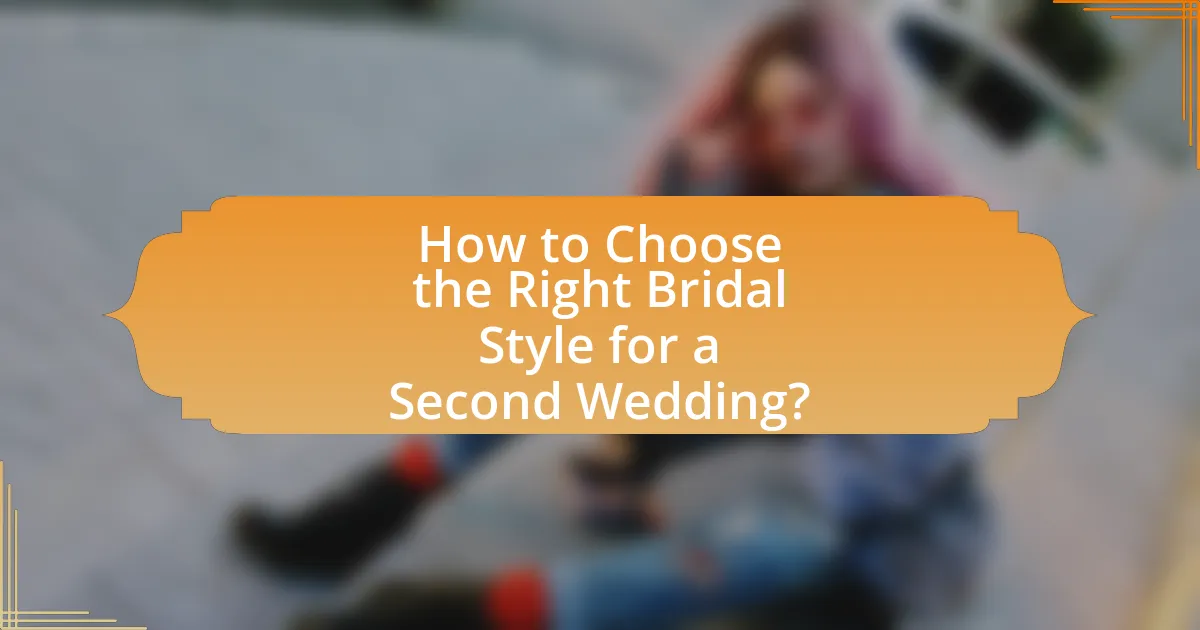
How to Choose the Right Bridal Style for a Second Wedding?
To choose the right bridal style for a second wedding, prioritize personal comfort and reflect your unique journey. Consider styles that are elegant yet understated, such as a chic cocktail dress or a sophisticated jumpsuit, which can convey a sense of maturity and confidence. Research indicates that many brides opt for non-traditional attire for second weddings, allowing for greater expression of individuality. Additionally, selecting fabrics like lace or silk can enhance the overall aesthetic while remaining appropriate for the occasion.
What factors should brides consider when selecting their second wedding attire?
Brides should consider personal style, venue, and formality when selecting their second wedding attire. Personal style ensures the outfit reflects the bride’s individuality, while the venue influences the choice of fabric and design; for example, a beach setting may call for lighter materials. The level of formality is crucial as it dictates whether a casual dress or a more formal gown is appropriate. Additionally, comfort is essential, as brides should feel at ease throughout the ceremony and reception. These factors collectively guide brides in making a thoughtful and suitable choice for their second wedding attire.
How does the bride’s body type influence dress selection?
The bride’s body type significantly influences dress selection by determining which silhouettes and styles will enhance her figure. For example, an hourglass figure typically suits fitted gowns that accentuate curves, while an apple-shaped body may benefit from A-line dresses that provide a balanced look. Additionally, brides with a pear shape often choose dresses that highlight the waist and flow over the hips, such as empire waistlines. This tailored approach to dress selection ensures that the chosen gown complements the bride’s unique shape, enhancing her confidence and comfort on her special day.
What budget considerations should be taken into account for second wedding attire?
When planning for second wedding attire, budget considerations include the cost of the dress or suit, alterations, accessories, and any additional expenses such as shoes and undergarments. The average cost of a wedding dress can range from $1,000 to $3,000, while suits may vary from $500 to $1,500, depending on the designer and fabric quality. Alterations typically add another $100 to $500, depending on the complexity of the changes needed. Accessories, including jewelry and veils, can further increase the budget by $200 to $1,000. Additionally, it is essential to consider the potential need for a second outfit for the reception, which can add another $500 to $2,000 to the overall budget.
What are some common mistakes to avoid when choosing a second wedding style?
Common mistakes to avoid when choosing a second wedding style include neglecting to consider the formality of the event, failing to reflect personal growth and changes since the first wedding, and overlooking the preferences of the new partner. Choosing a style that is too similar to the first wedding can lead to feelings of repetition, while opting for an overly extravagant style may not align with the couple’s current values or circumstances. Additionally, disregarding the venue’s atmosphere can result in a mismatch between the wedding attire and the setting, which can detract from the overall experience.
How can brides ensure their attire is appropriate for the occasion?
Brides can ensure their attire is appropriate for the occasion by considering the formality of the wedding, the venue, and personal style preferences. Selecting a dress that aligns with the event’s dress code, such as formal, semi-formal, or casual, is crucial; for instance, a formal wedding may require a long gown, while a beach wedding might be suited for a lighter, shorter dress. Additionally, understanding the venue’s atmosphere helps in choosing fabrics and styles that complement the setting, such as lace for a romantic garden or sleek satin for a modern urban space. Personal style should also reflect the bride’s comfort and individuality, ensuring she feels confident and authentic on her special day.
What should brides avoid to prevent overshadowing the significance of the event?
Brides should avoid overly extravagant attire and accessories to prevent overshadowing the significance of the event. Choosing a dress that is too elaborate can divert attention from the ceremony’s emotional essence, which is meant to celebrate love and commitment. For instance, a study by The Knot indicates that simplicity in wedding attire often resonates more with guests, allowing the focus to remain on the couple’s vows rather than on ostentatious fashion choices.
What practical tips can help brides select the perfect second wedding style?
Brides can select the perfect second wedding style by considering their personal preferences, the formality of the event, and the venue. Personal preferences should guide choices in color, silhouette, and overall aesthetic, ensuring the attire reflects the bride’s individuality. The formality of the event dictates whether a casual dress or a more formal gown is appropriate, while the venue influences fabric choices and design elements. For instance, a beach wedding may call for lighter fabrics and simpler designs, whereas a formal indoor ceremony might allow for more elaborate styles. Additionally, brides should consider incorporating elements from their first wedding to create a sense of continuity, while also embracing new styles that signify a fresh start.

